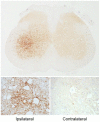The Expanding Therapeutic Utility of Botulinum Neurotoxins
- PMID: 29783676
- PMCID: PMC5983264
- DOI: 10.3390/toxins10050208
The Expanding Therapeutic Utility of Botulinum Neurotoxins
Abstract
Botulinum neurotoxin (BoNT) is a major therapeutic agent that is licensed in neurological indications, such as dystonia and spasticity. The BoNT family, which is produced in nature by clostridial bacteria, comprises several pharmacologically distinct proteins with distinct properties. In this review, we present an overview of the current therapeutic landscape and explore the diversity of BoNT proteins as future therapeutics. In recent years, novel indications have emerged in the fields of pain, migraine, overactive bladder, osteoarthritis, and wound healing. The study of biological effects distal to the injection site could provide future opportunities for disease-tailored BoNT therapies. However, there are some challenges in the pharmaceutical development of BoNTs, such as liquid and slow-release BoNT formulations; and, transdermal, transurothelial, and transepithelial delivery. Innovative approaches in the areas of formulation and delivery, together with highly sensitive analytical tools, will be key for the success of next generation BoNT clinical products.
Keywords: delivery; formulation; new indications.
Conflict of interest statement
All authors are Ipsen employees.
Figures



References
-
- Hill K.K., Smith T.J. Botulinum Neurotoxins. Springer; Berlin, Germany: 2012. Genetic diversity within Clostridium botulinum serotypes, botulinum neurotoxin gene clusters and toxin subtypes; pp. 1–20. - PubMed
-
- Peng L., Berntsson R.P.-A., Tepp W.H., Pitkin R.M., Johnson E.A., Stenmark P., Dong M. Botulinum neurotoxin DC uses synaptotagmin I and II as receptors, and human synaptotagmin II is not an effective receptor for type B, DC and G toxins. J. Cell Sci. 2012;125:3233–3242. doi: 10.1242/jcs.103564. - DOI - PMC - PubMed
Publication types
MeSH terms
Substances
LinkOut - more resources
Full Text Sources
Other Literature Sources

